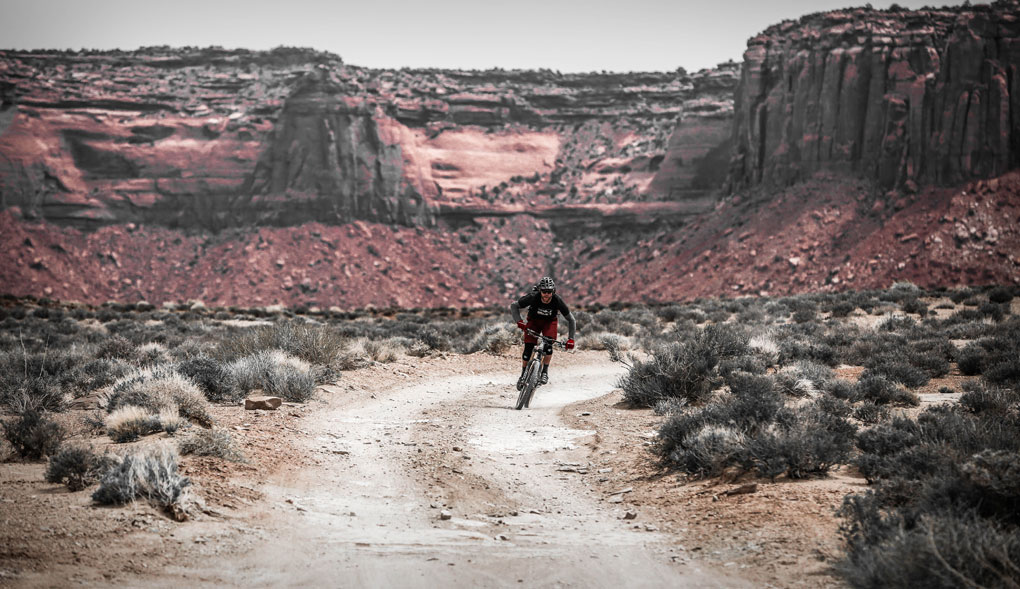Intended Use: Gravity / Park / All-Mountain
Size Tested: Medium
Bike Weight: stock w/ pedals: 34 lbs.; current set up: 34 lbs.
Geometry:
- Chain Stay Length: 17.3”
- Head Tube Angle: 66°
- Stand Over Height: 29.5″
- Seat Tube Angle: 70°
- Seat Tube Length: 17”
- Effective Top Tube Length: 23″
- Bottom Bracket Height: 13.7″
- Wheelbase: 43.6”
Modifications:
- KS LEV 125mm Dropper Post
- Maxxis Larsen 2.35 Tubeless Tires (for White Rim)
- Back to Maxxis Minion DHR 2.35 tires with standard tubes
Days Tested: 50+
Test Conditions: Ranging from loam to slick rock, single track to fire roads and most everything in between
Test Locations: Missoula & Whitefish, Montana; Moab, Fruita, & Colorado Springs, Colorado; Boise, Idaho.
Last September, I intended to replace my ‘09 Giant Reign X with a similar bike: a 6” all-mountain sled capable of long rides with extended climbs, but a machine that would still eat up rocky chunder on descents. I had a few bikes in mind that fit the bill—Banshee Rune V2, Pivot Firebird, the newly updated Reign X, etc.—but it wasn’t until I stumbled on the Diamondback Scapegoat’s build kit and geometry that I pulled the trigger and picked one up.
What particularly caught my eye about the Scapegoat is that while Diamondback markets the Scapegoat as a Gravity / Park bike—highlighting its beefed up frameset and long travel fork—they also claim it has “the agility and playfulness of an all mountain machine,” qualities I was looking for to replace the Reign.
I was able to get out a handful of times on the Scapegoat last year (see my first First Look review) but never on trails that really pushed the bike and allowed me to see what it could really do. For the most part, a bike like this is complete overkill for the buffed-out trails around Missoula. But fast-forward to this spring, and a two-week trip to Moab (including a full 100-mile White Rim trip aboard the ‘Goat) and a few rounds on the local DH tracks in Whitefish taught me a lot about the Scapegoat.

Before then, it seemed that every ride I went on, I’d compare the Scapegoat to other 6” bikes I’ve ridden, and I’d dwell on its relative shortcomings. I was expecting this bike to be the true “all-mountain machine” that Diamondback claimed it be, one that can climb as well as it descends. But I’ve since come to grips with the fact that that’s not the case. No matter how hard I tried to get the Scapegoat to climb better (tubeless tires, shortened stack height, reducing the fork 10mm), the fact remains: this bike is bred to bound down mountains, not up them.
Without swapping a ton of parts to make the Scapegoat more uphill friendly (for that, look into DB’s Mission line—essentially the same bike with a scaled back frame and 160mm fork), and despite DB’s claims of its all-mountain nature, when it comes to climbing, it will always be more at home in the lift line or in the back of a truck.
Once I embraced that side of the Scapegoat, I started to see the bike in a whole new light.
Here’s what I’m getting at…
Descents
Given the right pilot, the Scapegoat will demolish jump lines and steep trails. Its well-balanced nature makes jumping a ton of fun, and trails that have a good mix of hips, berms, and flow will feel like home on the Scapegoat. The bike definitely excels at machine- or hand-built flow lines, but is no sally when the going gets rocky.
While in Moab, I rallied the Scapegoat down Porcupine Rim, one of the best proving grounds out there for an all-mountain bike. The Notch? No problem. The Scapegoat felt comfortable and controlled in slow, steep, on-the-brakes, weight back, turn or die technical sections—surprising considering its tall fork and stack height. The 66-degree HT angle and 23” TT gets rider weight back fast when you need it.
At speed and pointed downhill, the Scapegoat puts rider position center-forward, exactly where it needs to be to slam the bike into corners and muscle through drop after drop. Porcupine’s numerous rock gardens, where line choice is somewhat critical, started to become a game of, “Can I smash through that?” Much to my surprise, the Scapegoat handled straight-line jaunts through boulder fields at ludicrous speeds. The overbuilt frame holds its ground and shows no sign of flex in these situations. Trust the 180mm Fox Float, and it will devour most anything short of small farm animals.

